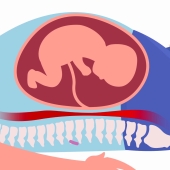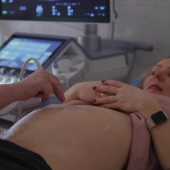Throughout the pregnancy the baby turns moves and turns around in the uterus a number of times. In the ninth month, the baby's front settles on the pelvic floor. 95%-97% fetuses are in a position where ther head is facing the birth canal. In 3%-5%, the baby is either breech (feet first) or transverse (the baby is in a sideways position).
External cephalic version is an attempt to turn the baby so that he or she is head down. It can improve your chance of having a vaginal birth. If the baby is breech and you are between 36 weeks and 38 weeks of pregnancy, your health care provider may suggest ECV.
The health care provider performs ECV by placing his or her hands on your abdomen. Firm pressure is applied to the abdomen so that the baby rolls into a head-down position. Two people may be needed to perform ECV. Ultrasound also may be used to help guide the turning.
The baby’s heart rate is checked with fetal monitoring before and after ECV. If any problems arise with you or the baby, ECV will be stopped right away. ECV usually is done near a delivery room. If a problem occurs, a cesarean delivery can be performed quickly, if necessary.
- 2463 views













